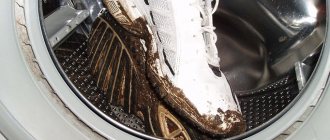The climatic conditions of our country are quite harsh, so warm clothes are an essential part of any person’s wardrobe. Wool sweaters are an excellent protection for the body from hypothermia in the cold season; they are warm, soft and comfortable. But often, an attempt to give things pristine cleanliness and freshness ends in complete failure - irretrievably damaged favorite clothes, at best, become the thing of someone close to them, very different in size from the previous owner, and at worst, they are sent to yarn, rags or straight into the trash can.
Helpful advice! To return a sweater that has stretched out after washing to its original size, you should wash it again in hot water and use cold water when rinsing.
A few general requirements
Each product has a label on which certain care features are indicated. If these recommendations related to washing and ironing are always followed, then the woolen item will retain its original appearance for a long time.
As a rule, a sweater is washed by hand, but there are products that are allowed to be washed by the CMA. For any of the above options there are certain features:
- The item should be washed as rarely as possible. Wool gets dirty a little, has the ability to self-clean, long-term water procedures are contraindicated for it;
- when the product has acquired foreign odors, it is recommended to ventilate it;
- soaking a wool sweater is prohibited to prevent it from stretching;
- the ideal water temperature for washing and rinsing is within thirty degrees;
- You should not create an alkaline environment for wool - the product will become hard;
- At the end of washing, do not twist the sweater to quickly wring it out. Wet wool fibers are susceptible to mechanical influences and are easily stretched and even torn.
Choosing a detergent
For wool products, special formulations should be used when washing - not all powders are suitable for such a procedure. Many people prefer liquid formulations - they quickly dissolve even in cold water and have a delicate effect during washing. For mohair or angora, they generally use simple shampoos.
In exceptional cases, it is allowed to use a soap solution made from laundry soap.
To keep a wool sweater soft and fluffy, use a wool softener. Lenor is considered an excellent solution; other conditioners designed for wool products are also suitable.
There is also a popular option - during the last rinse, glycerin is added to the water at the rate of a teaspoon per bucket.
Manual method
This method is considered the most correct, as it helps preserve the appearance of the sweater. When washing, certain rules must be followed:
- no pre-soaking is performed;
- The sweater must be turned inside out before washing;
- washing powder is not poured onto the item, but into water, shaken until foam forms;
- washing and rinsing are done in water at a temperature of thirty degrees so that the sweater does not shrink;
- The product should not be twisted. It is enough to squeeze it out a little and allow the water to drain on its own;
- to dry, the product is kept horizontally on terry towels, which are replaced as necessary;
- If the product has buttons, the loops should be basted so that they do not lose their shape.
It is recommended to wash woolen items with greasy stains with mustard powder.
To do this, dilute a glass of mustard with warm water to the consistency of a thin slurry. After this, the mixture is filtered into water, the temperature of which is forty to fifty degrees. The solution needs to sit for 2 - 3 hours, after which you can wash your woolen sweater in it. Washing is done without detergents, the solution is changed two to three times. Rinsing is done in water with the addition of ammonia at the rate of one spoon per bucket of water.
You can restore the freshness of the product in a simple way - dip the sweater in water to which lemon slices have been added.
HOW TO WASH?
Automatic washing is not contraindicated for woolen items, but it should be used in extreme cases. The best cleaning method is hand washing.
Manually
Water for hand washing should not be hot or cold - a temperature of +28...30°C is suitable. Clothes should be rinsed at the same temperature - a difference in indicators is undesirable.
Washing powder also matters. An incorrectly selected product will make the dies hard. It is better to use liquid powders and gels, shampoos. After the detergent has completely dissolved and foam appears, you can start washing. It is better to use specialized detergents for washing certain types of fabric and yarn.
Another secret of skillful housewives is to comb the pile against its direction, which will avoid the appearance of pellets. To avoid stretching the item, do not rub stains during washing. If the contamination is strong enough, you should first clean it with a brush. And only from the wrong side.
When washing by hand, it will be enough to blot a sweater or other item of clothing with water and apply slight pressure with your hands. Do these steps on each side. It is necessary to wring out the item easily, without twisting it in any way. The remaining water will disappear with proper drying, which also has its own subtleties.
Washing a sweater in an automatic machine
Carefully read the manufacturer's information on the label. If this is not possible, follow the general rules for washing wool products in a washing machine:
- You should not put cotton and linen items into the drum at the same time;
- The washing mode is used for delicate items;
- washing temperature is thirty degrees, the spin function is not activated;
- It is recommended to use liquid detergents; no conditioner is added;
- It is allowed to wash other items at the same time, even those that are approximately the same in shades and materials of manufacture.
Machine
Can a sweater be washed in a washing machine? Can. Thanks to new improvements, automatic laundry cleaning units have special cycles designed for...
If there is no "wool" cycle, the machine probably has a "delicate" or "hand wash" setting. The most important thing to do before washing clothes automatically is to check the label on the product. This will give details about the recommended method for cleaning your clothes.
Wool is a fine natural fiber that is prone to shrinking. To make clothes look attractive, you need to follow some rules.
How to wash a sweater in a washing machine:
- Turn the jumper inside out.
- Place in the washing machine drum.
- Pour detergent into the powder tray.
- Turn on wool, delicate or manual mode.
- Washing temperature - 20–30 degrees, rinsing temperature - 10 degrees.
- Turn off spinning and drying.
- Rinse by hand three times and change the water more if necessary.
- Squeeze out the moisture and send to dry.
If your washing machine has a fabric softener dispenser, fill it with 1 cup of vinegar. You can also add a few drops of lavender.
Why vinegar and not store-bought conditioner?
By adding vinegar to the rinse cycle, the pH of the wash water is adjusted to match the pH of the wool garment. Clothes will be cleaned without damage.
Vinegar is much cheaper than specialty detergents, and a large bottle will last a long time.
Plus, it doesn't contain harsh chemicals. It dissolves the remaining detergent, which is alkaline.
Vinegar is also an excellent stain remover.
Dry, iron, fix mistakes
Remember that even after proper washing, a wool item can lose its shape during drying. You should not hang the product on a clothesline and use clothespins - the item will be deformed.
Wool products are dried strictly horizontally, neatly straightened. The place should not be illuminated by the sun; the use of heating devices is completely excluded.
Occasional errors are easy to fix. Just pull the unfolded item in all directions to stretch it a little. But if you need to do the opposite, assemble the product and place it near a heat source. The method is emergency, and it is allowed to be used in exceptional cases when the question of further use of the sweater arises.
Most often, dry wool does not require ironing. But if necessary, using an iron is not prohibited. The temperature for this procedure is indicated on the label, but generally accepted rules can be used:
- Before ironing, the woolen item must be completely dry;
- the product is turned inside out; when ironing, gauze or a cotton rag is used;
- The iron is not “pulled”, but “lowered”. This precaution will help maintain the shape of the sweater;
- a good solution is a steam generator. With its help, you can remove wrinkles, refresh wool items, and even perform light cleaning.
Useful recommendations from experts
To everyone who values their wool sweater, we will reveal a number of secrets that will help in caring for the product.
If large dirty stains appear, it is recommended to dry them and scrub them with a dry bristle brush before washing. Do not work too hard to prevent pellets from forming.
Any yellowness that appears can be easily removed by soaking the sweater in water to which lemon juice has been added.
Has the product gone up a whole size? Don’t despair - soak it briefly in water at a temperature of fifty degrees. When only certain parts are stretched, wash only them. The time for the procedure is no more than ten minutes.
To speed up the drying process, experienced housewives offer a simple method. The sweater from which the water has drained is shaken and folded lengthwise. In this form, it is hung on the hanger crossbar, bent twice. After some time, the product is shaken thoroughly and returned to dry again, straightened and folded as before.
If there is a need to stretch the product a little, put it on a rope. But there is no firm guarantee that you will be able to achieve the desired effect.
Washing with mustard powder will help maintain the black shade of the sweater.
Whitening
Owners of products who accidentally spilled a drink or sauce on the item are looking for how to bleach a sweater.
In addition, over time, a white sweater may turn yellow. This occurs due to the use of incorrect detergents, frequent drying on heating devices or in direct sunlight.
How to whiten:
- Wash the item in cool water using laundry soap. How to wash it correctly: completely soak the sweater with soap, leave for 5 minutes and rinse. Then soak for 2 hours in a soda solution.
- You can bleach a sweater using peroxide. Hydrogen peroxide in a volume of 100 ml is diluted in 5 liters of water. The item is immersed in the solution for 1 hour.
- The pullovers are soaked in salty liquid. 40 grams of salt are dissolved in 10 liters of water. Soak the item for 1 hour, rinse 2-3 times.
- Sodium hyposulfite. How to bleach: dilute the powder with water, take a plastic bag, pour the liquid into it and place a sweater inside. The bag must be closed, after 30 minutes the sweater is rinsed.
Woolen items can be bleached using various home or pharmacy products. The main thing is to know when to stop.
You can also use chemical bleaches. This method is less safe, but also effective.
Any product that bears the “wool” designation is suitable for wool. You are allowed to use such tools as Vanish, Amway, Persol, Help.
Caring for acrylic and cashmere items
Modern products are often made from acrylic, which looks like wool, but is more durable to wear and less demanding in everyday care. In addition, sweaters made from this material are considered a fairly budget option, which is why they are in demand among many women.
Caring for acrylic is considered simple. Unlike analogues made from natural wool, such sweaters are easy to wash; they do not require special products; dirty stains can be removed from their surface without any problems. But there is still a minus - high water temperatures contribute to the stretching of the product.
When the manufacturer's instructions do not specify special requirements for the care of acrylic products, they can be safely machine washed. To avoid deformation of the sweater, it is recommended to wash it by placing it in a special bag, setting the delicate cycle and the water temperature to no more than thirty degrees. Spinning is allowed, but the number of drum revolutions should be minimal so that the sweater retains moisture when it is removed from the machine.
To dry, the product is laid out horizontally, with a towel spread underneath. Drying and storing on hangers are not recommended - the sweater quickly stretches out and loses its attractiveness. Ironing with a hot iron is prohibited.
Cashmere is considered the best material for a sweater. He gained his popularity for his beautiful appearance, tenderness and ability to retain heat. At the same time, products made from such material are quite expensive, and they require special attention to care. You should not believe the inscriptions on the label - washing is allowed only by hand, so as not to deform the product.
Washing in a washing machine
Using a machine for woolen items is not recommended. But this method is worth considering if it is not possible to wash a sweater or pullover by hand. However, this method should only be used in extreme cases. So, in order not to damage or at least minimize the risk of damage to woolen fabric, it is recommended to adhere to the following tips:
- Washing should only be done with a special detergent intended exclusively for woolen items. It is desirable that it be a liquid product.
- Along with the washing gel, it is imperative to add wool conditioner.
- It is not allowed to wash woolen items at the same time with other laundry.
- The mode should be selected “Delicate” or “Hand Wash”. It is worth noting that the “Wool” mode is not always able to protect the product from damage.
- The duration of washing should not exceed 30-40 minutes.
- The optimal water temperature is 30 degrees.
- A woolen item can be partially protected from damage by a laundry bag (the sweater should be placed inside the bag).
- It is better to disable the spin function. This is due to the fact that even at minimum speed reaches 500 rpm, which poses a significant danger to wool.











